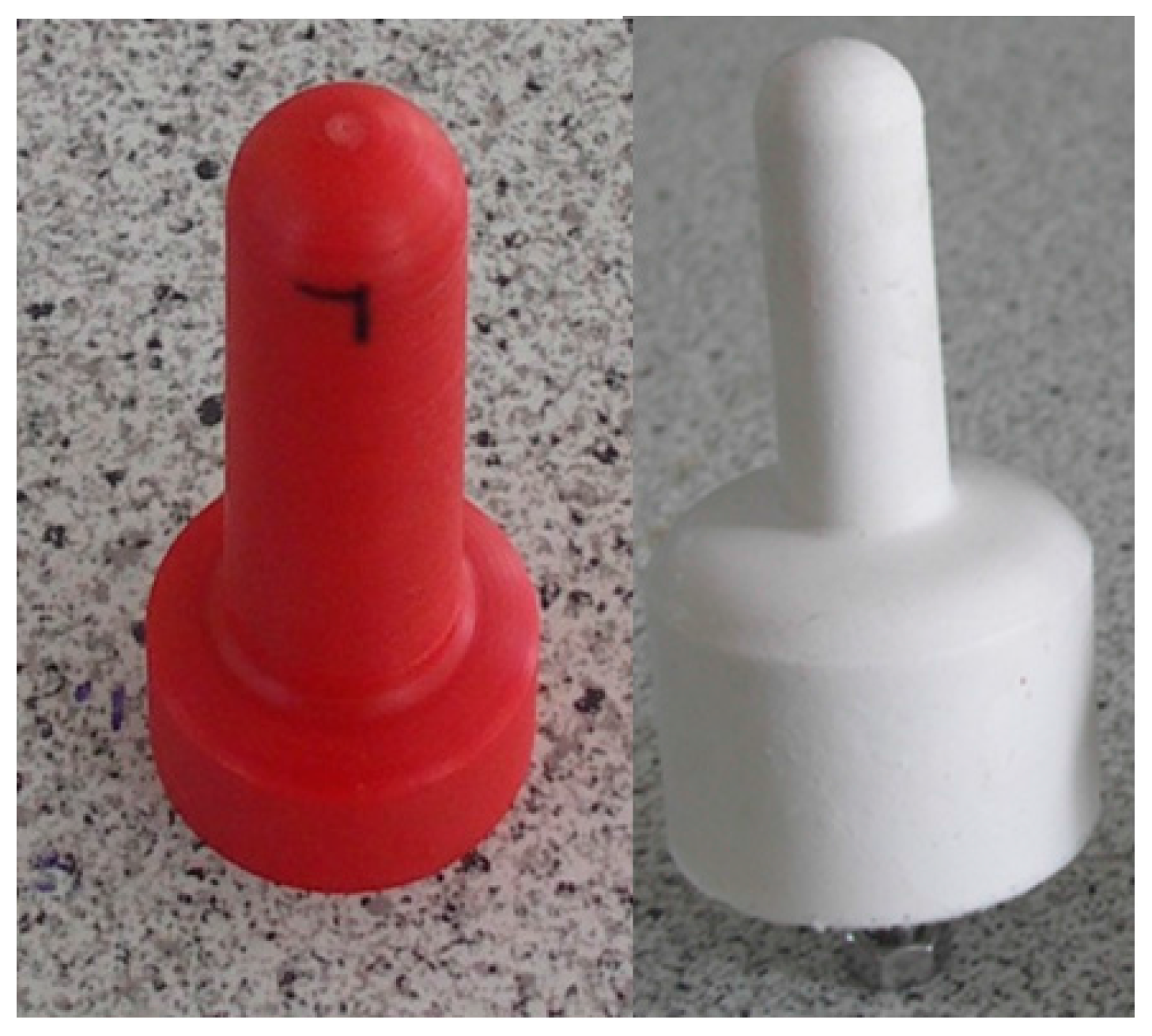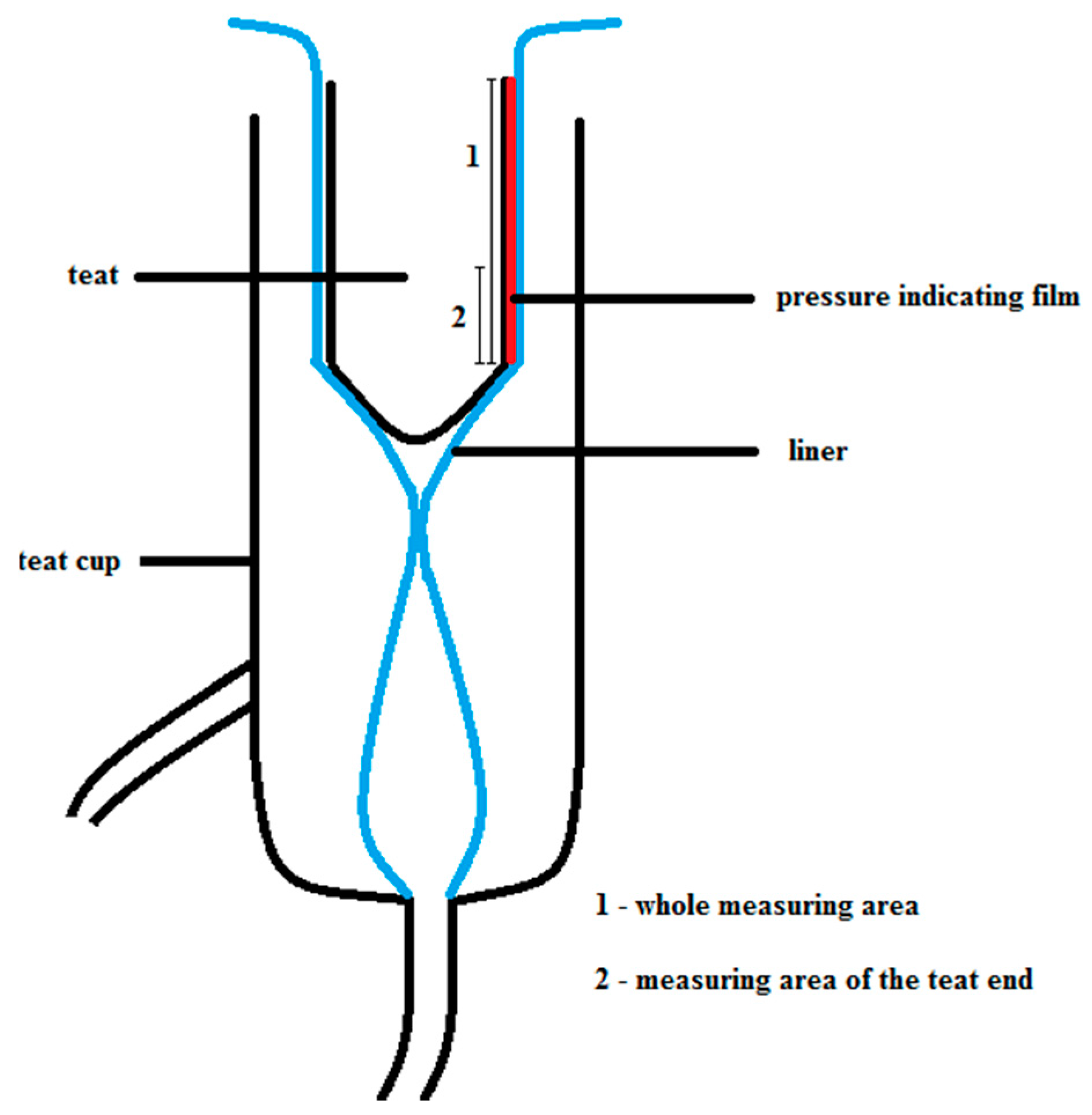The Usability of a Pressure-Indicating Film to Measure the Teat Load Caused by a Collapsing Liner
Abstract
:1. Introduction
2. Materials and Methods
2.1. Study Design and Data Collection
2.2. Pretest: Influence of Bending and Negative Pressure on the Measurements
2.3. Statistical Analyses
3. Results
3.1. Influence of Liner Collapse on Teat Load
3.2. Pretest: Influence of Bending and Negative Pressure on the Measurements
4. Discussion
5. Conclusions
Author Contributions
Conflicts of Interest
Abbreviations
| AP | average pressure |
| CA | colored area |
| CI | confidence interval |
| E1 | experiment one |
| E2 | experiment two |
| ER | effective rate |
| Film 1 | Ultra Super Low Prescale pressure-indicating film |
| Film 2 | Extreme Low Prescale pressure-indicating film |
| L | load |
| MA | measured area |
| MP | maximum pressure |
| PA | pressed area |
| Q1 | 25% quantile |
| Q3 | 75% quantile |
| Side A | the A-film of the pressure-indicating film |
| Side C | the C-film of the pressure-indicating film |
| STD | standard deviation |
References
- Neijenhuis, F.; Barkema, H.W.; Hogeveen, H.; Noordhuizen, J.P.T.M. Classification and longitudinal examination of callused teat ends in dairy cows. J. Dairy Sci. 2000, 83, 2795–2804. [Google Scholar] [CrossRef]
- Mein, G.A.; Neijenhuis, F.; Morgan, W.F.; Reinemann, D.J.; Hillerton, J.E.; Baines, J.R.; Ohnstad, I.; Rasmussen, M.D.; Timms, L.; Britt, J.S.; et al. Evaluation of bovine teat condition in commercial dairy herds: 1. Non-infectious factors. In Proceedings of the International Symposium on Mastitis and Milk Quality, Lelystad, The Netherlands, 13–15 September 2001.
- Alejandro, M.; Roca, A.; Romero, G.; Diaz, J.R. Effects of overmilking and liner type and characteristics on teat tissue in small ruminants. J. Dairy Res. 2014, 81, 215–222. [Google Scholar] [CrossRef] [PubMed]
- Mein, G.A.; Reinemann, D.J. Biomechanics of milking: Teat-liner interaction. In Proceedings of the American Society of Agricultural and Biological Engineers, Reno, NV, USA, 21–24 June 2009.
- Rosca, R.; Carlescu, P.; Tenu, I.; Chirila, C. Evaluation of a data aquision system for measuring the milking machine process parameters. Sci. Pap. Anim. Sci. Ser. 2012, 58, 285–290. [Google Scholar]
- Spencer, S.B.; Jones, L.R. Liner wall movement and vacuum measured by data acquisition. J. Dairy Sci. 2000, 83, 1110–1114. [Google Scholar] [CrossRef]
- Spencer, S.B.; Shin, J.W.; Rogers, G.W.; Cooper, J.B. Short communication: Effect of vacuum and ratio on the performance of a monoblock silicone milking liner. J. Dairy Sci. 2007, 90, 1725–1728. [Google Scholar] [CrossRef] [PubMed]
- Zucali, M.; Reinemann, J.D.; Tamburini, A.; Bade, R.D. Effects of liner compression on teat-end hyperkeratosis. In Proceedings of the American Society of Agricultural and Biological Engineers, Providence, RI, USA, 29 June–2 July 2008.
- Bade, R.D.; Reinemann, D.J.; Zucali, M.; Ruegg, P.L.; Thompson, P.D. Interactions of vacuum, b-phase duration, and liner compression on milk flow rates in dairy cows. J. Dairy Sci. 2009, 92, 913–921. [Google Scholar] [CrossRef] [PubMed]
- Mein, G.A.; Williams, D.M.D.; Reinemann, D.J. Effects of milking on teat-end hyperkeratosis: 1. Mechanical forces applied by the teatcup liner and responses of the teat. In Proceedings of the 42nd Annual Meeting of the National Mastitis Council, Forth Worth, TX, USA, 26–29 January 2003; pp. 114–123.
- Neijenhuis, F.; Klungel, G.H.; Hogeveen, H.; Noordhuizen, J.P.T.M. Machine Milking Risk Factors for Teat End Callosity in Dairy Cows on Herd Level; Wageningen Academic Publishers: Wageningen, The Netherlands, 2005; pp. 376–382. [Google Scholar]
- Muthukumarappan, K.; Reinemann, D.J.; Mein, G.A. Compressive load applied by the teatcup liner to the bovine teat. In Proceedings of the American Society of Agricultural Engineers Meeting, Chicago, IL, USA, 14–17 December 1993.
- Adley, N.J.D.; Butler, M.C. Evaluation of the use of an artificial teat to measure the forces applied by a milking machine teatcup liner. J. Dairy Res. 1994, 61, 467–472. [Google Scholar] [CrossRef] [PubMed]
- Davis, M.A.; Reinemann, D.J.; Mein, G.A. Development and testing of a device to measure compressive teat load applied to a bovine teat by the closed teatcup liner. In Proceedings of the American Society of Agricultural and Biological Engineers Annual Meeting, Sacramento, CA, USA, 29 July–1 August 2001.
- Van de Tol, P.P.J.; Schrader, W.; Aernouts, B. Pressure distribution at the teat-liner and teat-calf interfaces. J. Dairy Sci. 2010, 93, 45–52. [Google Scholar] [CrossRef] [PubMed]
- Leonardi, S.; Penry, J.F.; Tangorra, F.M.; Thompson, P.D.; Reinemann, D.J. Methods of estimating liner compression. J. Dairy Sci. 2015, 98, 6905–6912. [Google Scholar] [CrossRef] [PubMed]
- Cuffaro, V. Prediction Method for the Surface Damage in Splined Couplings. Ph.D. Thesis, Polytechnic University of Turin, Turin, Italy, February 2013. [Google Scholar]
- Rodríguez-Martínez, R.; Urriolagoitia-Sosa, G.; Torres-San Miguel, C.R.; Hernández-Gómez, L.H.; Urriolagoitia-Calderón, G.; Carbajal-Romero, M.F. Development of an experimental apparatus for testing a total knee prostheses focused on mexican phenotype. Int. J. Phys. Sci. 2012, 7, 5779–5786. [Google Scholar]
- Patterson, R.; Pogue, D.; Viegas, S. The effects of time and light exposure on contact and pressure measurements using Fuji prescale film. Iowa Orthop. J. 1997, 17, 64–69. [Google Scholar] [PubMed]
- Muthukumarappan, K.; Reinemann, D.J.; Mein, G.A. Compressive load applied to the bovine teat by the teatcup liner. In Proceedings of the American Society of Agricultural Engineers International Winter Meeting, Atlanta, GA, USA, 13–16 December 1994.




| Teat | Area | Film-Type | Variable | Median | Minimum | Q1 | Q3 | Maximum |
|---|---|---|---|---|---|---|---|---|
| Plastic | Whole | Film 1 | AP | 0.22 | 0.20 | 0.21 | 0.22 | 0.23 |
| MP | 0.64 | 0.47 | 0.64 | 0.64 | 0.64 | |||
| Film 2 | AP | 0.08 | 0.07 | 0.07 | 0.08 | 0.08 | ||
| MP | 0.23 | 0.21 | 0.23 | 0.23 | 0.24 | |||
| Teat end | Film 1 | AP | 0.26 | 0.22 | 0.25 | 0.27 | 0.33 | |
| MP | 0.64 | 0.46 | 0.64 | 0.64 | 0.64 | |||
| Film 2 | AP | 0.10 | 0.09 | 0.10 | 0.11 | 0.11 | ||
| MP | 0.23 | 0.21 | 0.23 | 0.23 | 0.24 | |||
| Silicone | Whole | Film 1 | AP | 0.22 | 0.20 | 0.22 | 0.23 | 0.27 |
| MP | 0.64 | 0.52 | 0.64 | 0.64 | 0.64 | |||
| Film 2 | AP | 0.08 | 0.08 | 0.08 | 0.09 | 0.10 | ||
| MP | 0.21 | 0.19 | 0.20 | 0.22 | 0.23 | |||
| Teat end | Film 1 | AP | 0.25 | 0.21 | 0.23 | 0.27 | 0.29 | |
| MP | 0.64 | 0.44 | 0.58 | 0.64 | 0.64 | |||
| Film 2 | AP | 0.09 | 0.08 | 0.09 | 0.10 | 0.12 | ||
| MP | 0.21 | 0.19 | 0.20 | 0.22 | 0.23 |
| Teat | Film Type | Area | Mean | Lower 95% CI of Mean | Upper 95% CI of Mean |
|---|---|---|---|---|---|
| Plastic | Film 1 | Whole | 13.5 | 5.1 | 31.2 |
| Teat end | 18.8 | 8.3 | 37.1 | ||
| Film 2 | Whole | 36.7 | 21.4 | 55.3 | |
| Teat end | 46.4 | 29.3 | 64.3 | ||
| Silicone | Film 1 | Whole | 21.7 | 10.3 | 40.2 |
| Teat end | 24.0 | 11.8 | 42.6 | ||
| Film 2 | Whole | 75.1 | 56.4 | 87.2 | |
| Teat end | 88.3 | 70.7 | 95.9 |
| Teat | Side | Film Type | CA (%) | CI of the Mean | AP (MPa) | CI | MP (MPa) | CI | |||
|---|---|---|---|---|---|---|---|---|---|---|---|
| Lower | Upper | Lower | Upper | Lower | Upper | ||||||
| Plastic | A | Film 1 | 1.1 | 0.000 | 99.5 | 0.17 | 0.16 | 0.17 | 0.35 | 0.30 | 0.41 |
| Film 2 | 9.9 | 0.35 | 77.6 | 0.06 | 0.06 | 0.07 | 0.15 | 0.13 | 0.17 | ||
| Silicone | A | Film 1 | 3.4 | 0.01 | 91.3 | 0.17 | 0.17 | 0.18 | 0.37 | 0.32 | 0.45 |
| Film 2 | 10.4 | 0.39 | 77.3 | 0.06 | 0.06 | 0.06 | 0.14 | 0.11 | 0.15 | ||
| Plastic | C | Film 1 | 3.8 | 0.02 | 89.8 | 0.18 | 0.17 | 0.18 | 0.42 | 0.39 | 0.44 |
| Film 2 | 10.8 | 0.43 | 77.1 | 0.06 | 0.06 | 0.07 | 0.16 | 0.14 | 0.23 | ||
| Silicone | C | Film 1 | 3.2 | 0.009 | 92.2 | 0.18 | 0.17 | 0.19 | 0.44 | 0.34 | 0.55 |
| Film 2 | 4.2 | 0.003 | 88.2 | 0.06 | 0.06 | 0.07 | 0.14 | 0.12 | 0.16 | ||
© 2016 by the authors; licensee MDPI, Basel, Switzerland. This article is an open access article distributed under the terms and conditions of the Creative Commons Attribution (CC-BY) license (http://creativecommons.org/licenses/by/4.0/).
Share and Cite
Demba, S.; Elsholz, S.; Ammon, C.; Rose-Meierhöfer, S. The Usability of a Pressure-Indicating Film to Measure the Teat Load Caused by a Collapsing Liner. Sensors 2016, 16, 1597. https://doi.org/10.3390/s16101597
Demba S, Elsholz S, Ammon C, Rose-Meierhöfer S. The Usability of a Pressure-Indicating Film to Measure the Teat Load Caused by a Collapsing Liner. Sensors. 2016; 16(10):1597. https://doi.org/10.3390/s16101597
Chicago/Turabian StyleDemba, Susanne, Sabrina Elsholz, Christian Ammon, and Sandra Rose-Meierhöfer. 2016. "The Usability of a Pressure-Indicating Film to Measure the Teat Load Caused by a Collapsing Liner" Sensors 16, no. 10: 1597. https://doi.org/10.3390/s16101597






